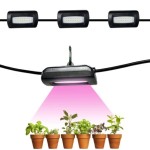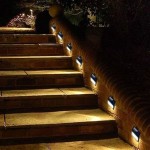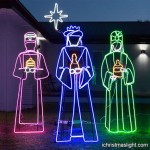Outdoor Light Sensors: Automating Illumination for Safety and Efficiency
Outdoor light sensors, also known as photocells or dusk-to-dawn sensors, provide an automated and energy-efficient way to manage outdoor lighting. These devices detect ambient light levels and activate connected lighting when darkness falls, deactivating them again at sunrise. This functionality offers several benefits for residential, commercial, and industrial applications.
Enhanced Security
Outdoor lighting plays a crucial role in deterring potential intruders. Light sensors ensure that exterior lights are activated consistently during hours of darkness, enhancing security around properties and creating a safer environment for residents, employees, and visitors. The predictable illumination eliminates the risk of forgetting to turn lights on manually, providing continuous protection.
Energy Conservation
A significant advantage of using light sensors is the reduction in energy consumption. By automatically switching lights off during daylight hours, these sensors eliminate unnecessary electricity usage. This leads to lower energy bills and contributes to a smaller carbon footprint, promoting environmentally responsible practices.
Convenience and Automation
Light sensors provide a convenient and hassle-free way to manage outdoor lighting. They eliminate the need for manual switching, ensuring lights are always on when needed and off when not required. This automation simplifies lighting control, especially for large properties or areas with multiple lights.
Types of Outdoor Light Sensors
Several types of outdoor light sensors are available, each with unique characteristics and applications. Understanding these distinctions is crucial for selecting the appropriate sensor for a specific need.
Photoresistors
Photoresistors, or light-dependent resistors (LDRs), are simple and cost-effective sensors. Their resistance changes in response to light intensity, allowing them to control the flow of current to a connected light fixture. However, they can be susceptible to temperature variations and may not be as accurate as other sensor types.
Photodiodes
Photodiodes are semiconductor devices that generate a current proportional to the incident light. They offer faster response times and greater accuracy compared to photoresistors, making them suitable for applications requiring precise light detection.
Phototransistors
Phototransistors are similar to photodiodes but offer higher sensitivity to light. They are commonly used in applications where a small amount of light needs to trigger a significant change in current, such as in security systems.
Selecting the Right Outdoor Light Sensor
Choosing the correct outdoor light sensor involves considering several factors, including the type of light fixture, mounting location, and desired sensitivity. Understanding these aspects helps ensure optimal performance and functionality.
Voltage and Load Capacity
Ensuring compatibility between the light sensor and the connected light fixture is critical. The sensor must be rated to handle the voltage and wattage of the light it controls. Exceeding the sensor's load capacity can lead to malfunction or damage.
Mounting Location and Adjustment
The location of the light sensor significantly influences its performance. It should be placed where it can receive unobstructed sunlight during the day while avoiding direct exposure to artificial light sources at night. Many sensors offer adjustable sensitivity settings, allowing users to fine-tune the activation and deactivation thresholds.
Weather Resistance
Outdoor light sensors are exposed to the elements, requiring suitable protection from rain, snow, and extreme temperatures. Choosing a sensor with appropriate weatherproofing ensures reliable operation in various climates and prolongs its lifespan.
Integration with Smart Home Systems
Modern light sensors can integrate with smart home systems, offering advanced control and automation capabilities. These integrations allow users to remotely manage outdoor lighting, schedule on/off times, and even incorporate light sensors into broader home automation scenarios.
Motion Sensing Capabilities
Some outdoor light sensors combine light detection with motion sensing. These dual-functionality devices activate lights only when both darkness and motion are detected, further enhancing security and energy efficiency. This is particularly beneficial for areas where constant illumination is unnecessary, such as walkways or driveways.
Choosing the right outdoor light sensor depends on the specific application and desired functionality. Careful consideration of these factors will result in a system that provides efficient and reliable automated lighting control.

Auraglow Pir Motion Sensor Up Down Outdoor Wall Security Light Warminster Stainless Steel Led Lighting

Outside Light Level Sensor Multi Ranging Lux 0 10vdc Output Buy Ec S

Sambesi Pir Sensor Outdoor Wall Light

Outdoor Light Intensity Sensor Ahkf

Defiant 180 Degree Motion Sensor White Outdoor Security Light Df 5416 Wh A The Home Depot

Lepro 20w Security Lights Outdoor Motion Sensor 1700 Lumen Pir Light Ip65 Waterproof Flood

Ip54 Outdoor Light Sensor Switch Photocontrol China Photocell Control Made In Com

Philips Hue Outdoor Motion Sensor Review Macrumors

Up And Down Pir Motion Sensor Wall Light For Outdoor Use

Country Cottage Black Motion Sensor Outdoor Wall Light H6924 Lamps Plus
Related Posts







